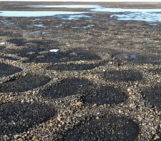
My name is Kathi Unglert, and I’m reporting from the EGU 2016 General Assembly as part of the EGU student reporter programme. Below is my second contribution to the Cryosphere Blog – this time about how cryosphere research can have a real impact on people’s lives.
Antoni Lewkowicz – he’s famous, according to a comment I overheard in Tuesday’s PICO session on applied geophysics in cryosphere research. I’m a volcanologist, so I guess I wouldn’t know. But what I do know is that he’s a passionate scientist. His PICO presentation got my curiosity, but what really grabbed my attention is a small statement he made during the subsequent discussion of his PICO poster. But I’m getting ahead of myself.
One thing I’ve learned over the last few days is that cryospheric research can have a big impact on people’s lives. Antoni’s work is part of a project on the effects of a changing environment in Northern Canada, and on adaptation to climate change. The Yukon is Canada’s northwestern most territory, right on the border to Alaska. It’s about twice the size of the UK, but with just under 40,000 people its population is lower than 0.1% of the UK’s population. You can imagine the vast wilderness in the Yukon. Yet, for the people living in this part of the world, climate change is happening right now. Permafrost is disappearing (see the blog Image of The Week from last Friday), and the thawed ground is the foundation of now wonky houses. Among others, the Kluane First Nation and their territory are threatened by the disappearance of frozen ground. They have teamed up with various universities and research institutes for Antoni’s climate change adaption and hazard mapping project to identify regions where future construction is less likely to be affected by thawing permafrost. The project reveals that on previously burnt ground, where the permafrost has already thawed, the shallow ground is less likely to move and settle any further, so it’s safer for buildings.
Ludovic Ravanel also studies permafrost. The researcher and mountain guide has set up a network of observers – fellow guides, hut keepers, cable car operators and more – to monitor rockfalls at Aiguille du Midi, a peak at over 3,800 m altitude in the Mont Blanc Massif in France. Even a small chunk of rock that tumbles down the steep slopes of the Massif can be fatal. Ludovic’s records show that during heat waves such as the one that happened in the summer of 2015, there are many more rockfalls than during colder years. During that year, at least one person lost their life because of crumbling parts of the mountain. On the poster in the permafrost open session on Wednesday, Ludovic and colleagues summarize the results from years of monitoring, and conclude that the rockfalls can clearly be attributed to thawing permafrost. This is bad news. The good news is that the observer network works well to alert the community of increased rockfall activity. Climbing routes can be closed, and protective measures can be introduced to keep falling rocks from getting to areas where people are, or from hitting important infrastructure.

Steep peak in the Mont Blanc Massif. Thawing permafrost can cause fatal rockfalls. Photo credit: Christian Massari (Imaggeo)
The results from both studies are extremely important and have the potential to reduce costs to the community as well as transform and even save people’s lives. During Antoni’s presentation, the comment that led to this article was that the Kluane First Nation decided not to follow Antoni’s and his colleagues’ recommendation for where to build new homes. As Antoni says, people are people after all, and who wouldn’t like to build their house next to some nice trees, instead of burnt ground with some small shrubs. In contrast, Ludovic is happy with the actions taken at Aiguille du Midi following his research. However, in a comment concluding our conversation he admits that things might look different if he wasn’t local to Chamonix and if he wasn’t a mountain guide. In other words, his work has such a positive impact partly because he is very much part of the community and enjoys a level of trust that one might not be able to gain as an “outsider”.
Read more about the Yukon Hazard Mapping project in one of their reports here, or about the effect of thawing permafrost on the Mont Blanc Massif in this paper, published in The Cryosphere.
(Edited by Emma Smith)
Kathi Unglert is a PhD student in volcanology at the University of British Columbia, Vancouver. Her work looks at volcanic tremor, a special type of earthquake that tends to happen just before or during volcanic eruptions. She uses pattern recognition algorithms to compare tremor from many volcanoes to identify systematic similarities or differences. This comparison may help to determine the mechanisms causing this type earthquake, and could contribute to improved eruption forecasting. You can find her on Twitter (@volcanokathi) or read her volcano blog.







Pingback: Cryospheric Sciences | Image of The Week – Tumbling Rocks